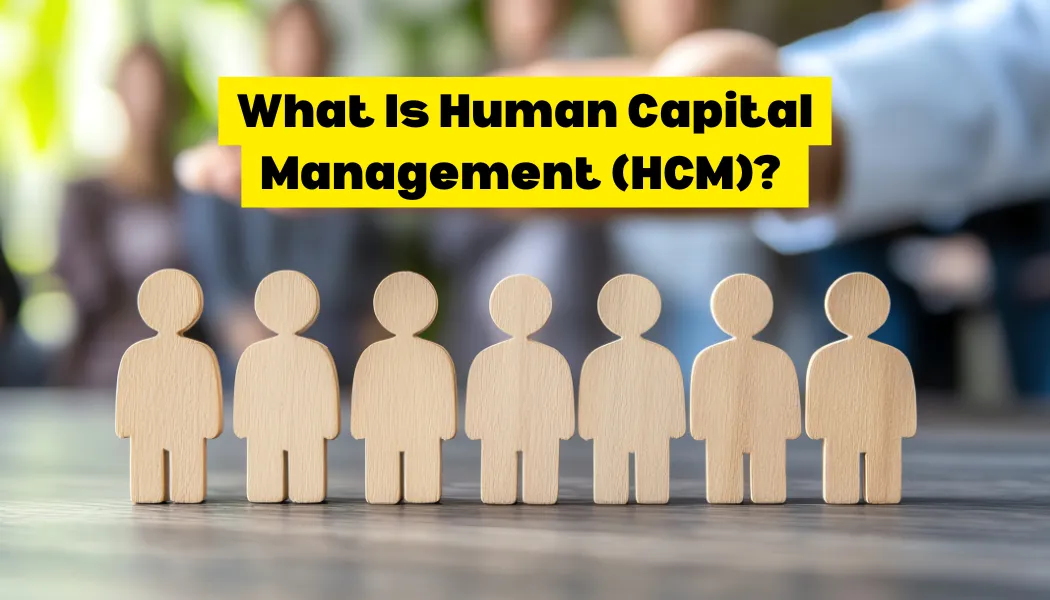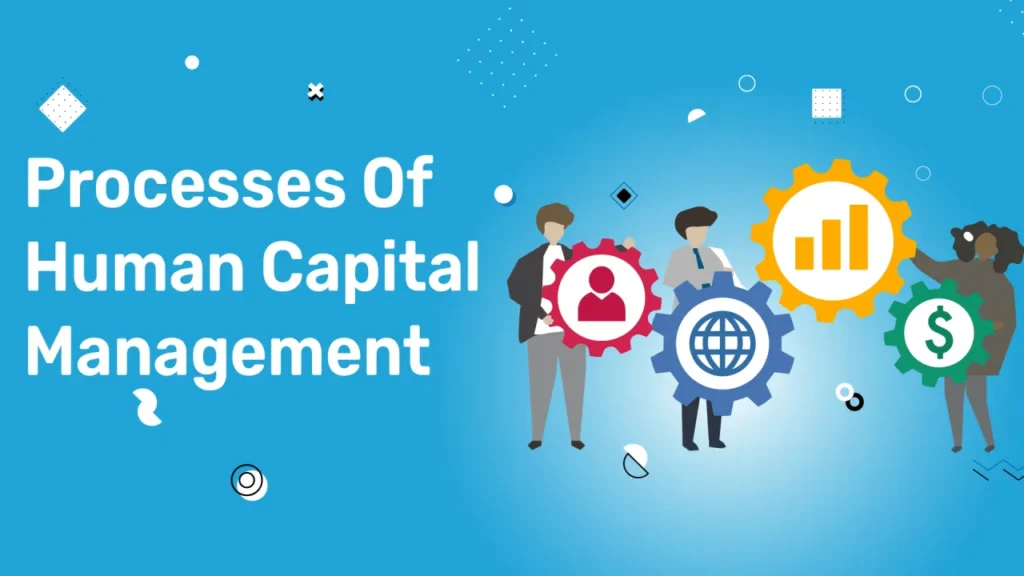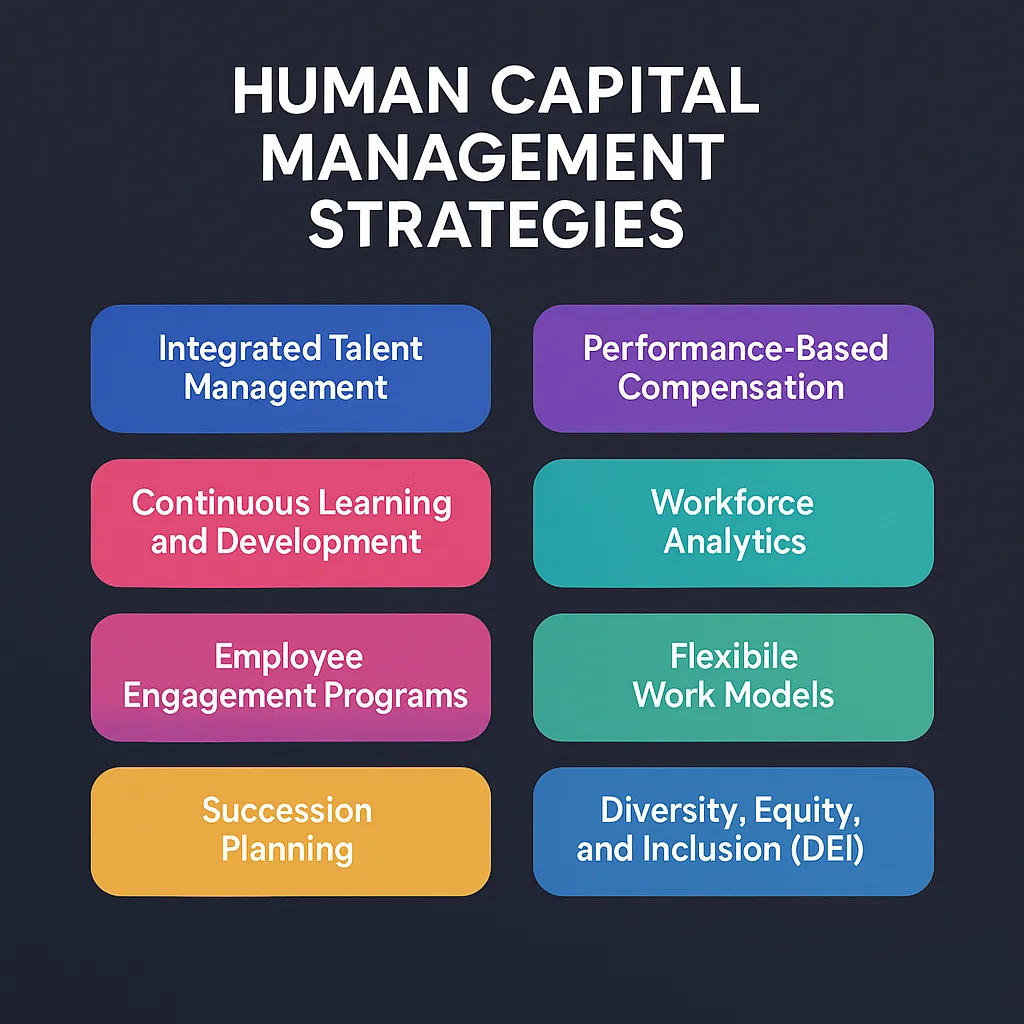
Executive Summary
Human Capital Management (HCM) is a strategic approach to managing an organization’s most valuable asset—its people. Unlike traditional human resource management, which primarily handles administrative tasks, HCM focuses on optimizing employee performance, development, engagement, and retention to drive business outcomes.
At its core, HCM involves managing the entire employee lifecycle—from recruitment and onboarding to learning, performance management, succession planning, and workforce analytics. Organizations that implement effective HCM strategies align employee goals with organizational objectives, improve productivity, and gain a competitive advantage in the market.
This guide provides an in-depth look at HCM, including its concepts, processes, benefits, strategies, challenges, tools, real-world applications, metrics, future trends, and best practices.
Table of Content
- Executive Summary
- Table of Content
- Introduction
- Core Concepts of Human Capital Management
- Key Processes in Human Capital Management
- Benefits of Human Capital Management
- Human Capital Management Strategies
- Tools and Technologies in Human Capital Management
- Challenges in Human Capital Management
- Real-World Applications
- Key Metrics and KPIs
- Common Misconceptions
- Future of Human Capital Management
- Best Practices for Effective HCM
- Conclusion
Introduction
In today’s fast-paced business environment, employees are no longer just resources—they are strategic assets. Human Capital Management recognizes that the value of an organization is directly tied to the capabilities, performance, and engagement of its workforce.
HCM is a holistic approach that combines strategy, technology, and human resource practices to maximize the potential of employees while supporting organizational goals. By treating employees as investments rather than costs, organizations can cultivate a workforce that is skilled, motivated, and adaptable to evolving business demands.
Unlike traditional HR, which focuses on compliance and payroll, HCM emphasizes strategic workforce planning, talent development, and performance optimization. It ensures that the organization has the right people, with the right skills, in the right positions, at the right time.
Core Concepts of Human Capital Management
- Talent Acquisition and Recruitment – Attracting and hiring employees with the right skills, experience, and cultural fit.
- Onboarding and Integration – Helping new employees quickly adapt to the organization and become productive.
- Learning and Development – Enhancing employee skills through continuous education, training, and career growth opportunities.
- Performance Management – Monitoring and improving employee output to align with organizational objectives.
- Employee Engagement and Motivation – Creating a positive work environment that encourages commitment and productivity.
- Succession Planning – Preparing future leaders and ensuring organizational continuity.
- Compensation and Benefits Management – Designing competitive packages to attract and retain top talent.
- Human Capital Analytics – Using data-driven insights to make informed workforce decisions.
- Compliance and Risk Management – Ensuring adherence to labor laws, regulations, and ethical practices.
Each of these concepts forms a critical pillar of HCM, ensuring a comprehensive approach to workforce optimization.
Key Processes in Human Capital Management

1. Talent Acquisition and Recruitment
Talent acquisition involves identifying, attracting, and hiring individuals who can contribute to organizational goals. Effective recruitment ensures that the organization secures employees with the right technical and soft skills.
Key steps include:
- Defining roles and responsibilities clearly.
- Sourcing candidates through multiple channels like job portals, social media, and referrals.
- Conducting structured interviews, assessments, and background checks.
- Aligning hiring decisions with long-term organizational needs and culture.
2. Onboarding and Integration
Successful onboarding integrates new hires into the organizational culture and equips them with the tools and knowledge needed to perform effectively. A structured onboarding process improves retention, engagement, and productivity.
Activities include:
- Orientation programs introducing policies, values, and workflows.
- Mentorship and peer support programs to guide new employees.
- Early performance check-ins to address challenges and set expectations.
3. Learning and Development
Learning and development is a continuous process that empowers employees to acquire new skills and enhance existing ones. It ensures that the workforce remains competitive and adaptable to changing business requirements.
Components include:
- Formal training programs and workshops.
- Online learning platforms and e-learning courses.
- Leadership development initiatives.
- Cross-functional assignments to build diverse skills.
4. Performance Management
Performance management is the systematic evaluation of employee contributions to ensure alignment with organizational objectives. It combines goal setting, ongoing feedback, performance appraisals, and coaching.
Key steps:
- Setting SMART (Specific, Measurable, Achievable, Relevant, Time-bound) goals.
- Conducting regular performance reviews and feedback sessions.
- Offering coaching and corrective guidance for continuous improvement.
- Linking performance to rewards, recognition, and career progression.
5. Employee Engagement and Retention
Employee engagement measures how committed and motivated employees are toward their work and organization. High engagement reduces turnover, increases productivity, and fosters a positive workplace culture.
Strategies include:
- Recognition programs, awards, and incentives.
- Surveys and feedback mechanisms to address employee concerns.
- Team-building activities and social events to strengthen workplace relationships.
- Career development opportunities to retain top talent.
6. Succession Planning
Succession planning ensures organizational stability by preparing high-potential employees for leadership and critical roles. It minimizes disruption caused by turnover or promotions.
Steps include:
- Identifying key roles and potential successors.
- Creating individual development plans for high-potential employees.
- Providing mentoring, coaching, and training to prepare future leaders.
7. Compensation and Benefits Management
Competitive compensation and benefits packages attract and retain top talent. HCM integrates salary, incentives, perks, and benefits into a strategic framework that aligns with employee performance and organizational goals.
Key considerations:
- Benchmarking salaries against industry standards.
- Offering performance-based incentives.
- Providing health, retirement, and wellness benefits.
- Tailoring packages to meet employee needs and enhance satisfaction.
8. Human Capital Analytics
Data-driven insights are critical for effective HCM. Workforce analytics provides information on performance trends, engagement levels, turnover, and skills gaps.
Applications include:
- Predicting future talent needs and risks.
- Measuring the ROI of recruitment, training, and development initiatives.
- Optimizing workforce planning and allocation.
- Supporting strategic decisions on promotions, rewards, and succession planning.
9. Compliance and Risk Management
Ensuring compliance with labor laws, regulations, and ethical standards protects organizations from legal risks and reputational damage.
Key practices include:
- Monitoring HR policies for legal adherence.
- Conducting regular audits and compliance training.
- Mitigating risks associated with workplace harassment, discrimination, or unethical practices.
Benefits of Human Capital Management
- Strategic Workforce Alignment – Ensures employees’ work contributes directly to organizational goals.
- Improved Productivity – Optimizes performance through development and effective performance management.
- Enhanced Employee Engagement – Motivates employees by providing recognition, development, and support.
- Talent Retention – Reduces turnover through career growth opportunities and competitive rewards.
- Leadership Development – Prepares employees for future critical roles, ensuring continuity.
- Data-Driven Decision-Making – Uses analytics to improve workforce strategies and outcomes.
- Cost Optimization – Reduces recruitment, training, and HR operational costs through efficiency.
- Compliance and Risk Mitigation – Ensures adherence to laws, reducing legal and operational risks.
Human Capital Management is deeply connected with other key areas of business strategy that focus on maximizing people’s potential and aligning them with organizational goals.
To learn how companies nurture and retain top talent, read What Is Talent Management? — a deep dive into building high-performing teams.
For a broader view on managing employees and optimizing operations, check out What Is Workforce Management?
If you’re interested in leadership advisory and organizational improvement, explore What Is Management Consulting?, which explains how consultants help design effective people strategies.
Learn how technology supports people-centric management in What Is Customer Relationship Management (CRM)?.
You can also explore how similar principles of management apply across industries in What Is Sports Management? and What Is Pain Management? — where performance, care, and motivation come together.
For professionals aiming to scale organizational systems, What is program management? offers an overview of managing multiple initiatives aligned with workforce goals.
Human Capital Management Strategies

- Integrated Talent Management: Connect recruitment, development, performance, and succession planning.
- Continuous Learning and Development: Promote lifelong learning to keep skills relevant.
- Employee Engagement Programs: Foster motivation, collaboration, and satisfaction.
- Succession Planning: Prepare future leaders and secure critical roles.
- Performance-Based Compensation: Reward achievements and contributions.
- Workforce Analytics: Track metrics, identify trends, and forecast talent needs.
- Flexible Work Models: Offer hybrid and remote options to meet employee expectations.
- Diversity, Equity, and Inclusion (DEI): Integrate inclusive practices into talent management.
Tools and Technologies in Human Capital Management
- HCM Platforms: Workday, SAP SuccessFactors, Oracle HCM Cloud, ADP Workforce Now
- Recruitment Tools: LinkedIn Talent Solutions, Indeed, Glassdoor
- Learning and Development Systems: Cornerstone OnDemand, Docebo, Udemy for Business
- Performance Management Tools: Lattice, 15Five, Culture Amp
- Employee Engagement Platforms: Officevibe, Glint, Qualtrics
- Workforce Analytics Tools: Visier, PeopleInsight, Tableau
- Collaboration Tools: Microsoft Teams, Slack
These tools streamline HCM processes, improve accuracy, and enable organizations to make strategic workforce decisions.
Challenges in Human Capital Management
- Talent Shortages: Difficulty in finding qualified candidates.
- High Turnover Rates: Losing valuable employees to competitors.
- Rapid Workforce Changes: Adapting to evolving skills and expectations.
- Integration of Systems: Ensuring HCM tools and platforms work together seamlessly.
- Leadership Gaps: Preparing employees effectively for critical roles.
- Employee Engagement: Maintaining motivation over time.
- Measuring ROI: Quantifying the impact of HCM initiatives on business performance.
Real-World Applications
- Corporate Organizations: Aligning workforce strategy with business objectives.
- Healthcare: Recruiting, training, and retaining skilled medical professionals.
- Education: Developing and retaining top educators and administrative staff.
- Government and Public Sector: Managing workforce planning and leadership development.
- Technology Firms: Attracting, nurturing, and retaining talent for innovation.
- Hospitality and Service Industry: Optimizing staffing, performance, and satisfaction.
Key Metrics and KPIs
- Employee Retention Rate: Percentage of employees staying over a period.
- Time-to-Hire: Average duration to fill open positions.
- Employee Engagement Score: Level of employee satisfaction and motivation.
- Performance Achievement Rate: Percentage of employees meeting performance goals.
- Succession Readiness: Availability of high-potential employees for critical roles.
- Training Completion Rate: Percentage completing development programs.
- Talent ROI: Return on investment for HCM strategies.
Common Misconceptions
- HCM is Only for Large Companies: Small and medium enterprises also benefit.
- It’s Just HR Administration: HCM is strategic and focuses on workforce optimization.
- Technology Alone Solves Challenges: Tools assist, but strategy and leadership remain critical.
- It Only Focuses on Recruitment: HCM spans the full employee lifecycle.
- Employees Are Just Resources: HCM treats employees as valuable assets.
Future of Human Capital Management
- AI and Automation: Streamlining recruitment, performance tracking, and analytics.
- Personalized Employee Experience: Tailoring career growth, benefits, and engagement.
- Remote and Hybrid Workforce Management: Adapting strategies for distributed teams.
- Predictive Analytics: Forecasting talent gaps, turnover, and workforce needs.
- Continuous Learning Culture: Emphasizing lifelong learning and upskilling.
- Diversity, Equity, and Inclusion (DEI): Ensuring fairness and inclusion.
- Employee Wellbeing Integration: Supporting mental, physical, and professional wellbeing.
Best Practices for Effective HCM
- Align human capital strategy with organizational goals.
- Foster a culture of continuous feedback and development.
- Use data and analytics to guide workforce decisions.
- Invest in learning and development programs.
- Recognize and reward high-performing employees.
- Plan for succession and leadership development proactively.
- Maintain transparency, fairness, and inclusivity in all processes.
Conclusion
Human Capital Management is a strategic, holistic approach to managing an organization’s workforce as a critical asset. By integrating talent acquisition, onboarding, learning and development, performance management, succession planning, engagement, analytics, and compliance, HCM enables organizations to optimize employee potential, improve productivity, and achieve long-term success.
Effective HCM transforms employees into high-performing, engaged contributors, driving innovation, growth, and a sustainable competitive advantage. Organizations that invest in human capital management ensure that their workforce remains motivated, skilled, and aligned with evolving business needs, ultimately supporting organizational excellence in a dynamic global economy.


